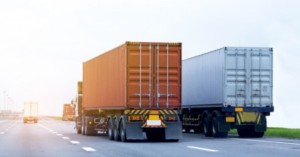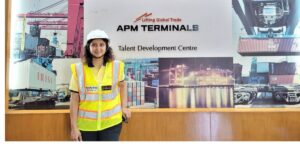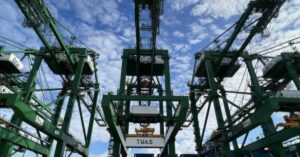VS&B Containers Group is into container trading for the past 25 years. They buy and sell over 15,000 containers annually, supply custom-built and standard containers, operate one of India’s largest fleets of domesticated (customs duty paid) containers for use in coastal movement, road transport, rail transport and factory storage. This is currently the largest leasing company based in the Indian Sub-Continent and the Middle-East.
Bijoy Paulose, Chairman and Managing Director of the company details on their business, the current market scenario and shares a vision to be one of the largest container traders in the world in the next 5 years.
It is the silver jubilee year of VS&B. Can you give me a brief on what are the important milestones in this journey and how the business evolved over a period of time?
We started off in 1996 as agents for Cronos Containers. They were one of the largest container leasing companies. It’s a British-American company headquartered in San Francisco and we started off as agents for them in India. Frankly at that time, my connect with them was I was supplying containers from Balmer & Lawrie to Cronos from the container manufacturing plant at Chennai and Cochin, that’s how I came into contact with them. So, they asked me, I agreed, and thus VS&B was born. But within a year fortunately we did well so slowly area started getting added on. Within two years we became an area office for Cronos which meant we had the same authority and responsibility like any other own office of theirs and we were made area office for the Indian subcontinent. From there it was made Indian subcontinent and Middle East and then Indian subcontinent, Middle East and South Africa. The fact is, in all these places which were added on, it was Cronos closing its own office and handing it over to VS&B as an agent. So, very quickly, in about 5 years’ time, Cronos became the largest container leasing company in terms of fleet out of India and Middle East, though worldwide Cronos is only the 5th largest container leasing company but they were the largest in this region. That is the kind of business that we were able to bring. If I talk about milestones, there are two aspects – one would be the business side of it. We did the business growth first as agents, then in about 4 years, in order to enhance Cronos business, we started leasing containers from them and sub-leasing it to the smaller NVOs, smaller lines in India, Middle East, who are not being served by the large leasing companies, because many of them had their own challenges. Their balance sheets would not meet…you know at that time, I am talking about 20 years ago, foreign exchange regulations when they couldn’t pay in Dollars, etc. So, what we did is we got Reserve Bank approval, we started to lease boxes and slowly started building up a container fleet ourselves but everything under the umbrella of Cronos. Everything was done jointly so much so that I was also a small stakeholder in Cronos after about 10 years because they felt our business was valuable enough to give me a small share. That’s how the business developed, from container agency to container leasing, then we started domestic leasing. We are one of the largest domestic leasing companies today in India. Then we looked at trading as a natural corollary to their business and therefore trading started in a small way in 2006 or so. Today, we are probably one of the largest traders again in this India, Middle East region. Then, we started positioning containers. So, we ran out of containers in India and therefore what we did is VS&B started to make arrangements to move Cronos Containers from US and Europe which was an extremely successful programme. We cleaned up the entire ARHBS they call it Antwerp, Rotterdam, Hamburg, Bremerhaven stocks of 40 ft high cubes. Then we moved over to US East Coast and cleaned up the entire …moved close to 20,000 containers to India. So, revenue for Cronos and revenue for us. Similarly, well we became a kind of a solution finder for Cronos and then so they came up with this issue that they were having with the software that they were using which was an EDI and they were having problems in the software, that is the support was not good, it is an American company which was taken over etc. So, both of us decided why don’t we just try starting a…I have always believed that if you have a customer, you can start any business…so on that basis, we started a small software company with the understanding that if things don’t work in 6 months after the product is launched, if Cronos does not find it worth it, both of us will just forget that we invested a small amount of money in it. But things worked well, 17 years later that software company today deals with about 8 international leasing companies for their gate-in, gate-out, the EDI transmission. 1700 depots transmit through that network, CMA CGM handles their entire repair and recovery process through a software developed by us and maintained by us so on and so forth. We have trading software etc. Then we decided to move on. Somewhere 5 years ago, Cronos got sold so I lost a huge partner in Cronos. It was taken over by another leasing company. At that time, we decided that then we were allowed, we had the freedom to do what we wanted completely, right. So, we decided to make ourselves a full-fledged container leasing and trading company. So, immediately we started an office in Singapore, then in Indonesia, and expanded our office in Dubai and two years ago, just before COVID hit, we started our office in Germany. So, from container trading, we moved on to one-trip containers which is primarily moving new boxes built specifically for the European hinterland, in Germany, Poland, Czechoslovakia, Hungary, etc. So, that’s been our journey.
Can you explain a little bit about the container leasing and container trading part of it? How does this work and how much of percentage of your business is now into leasing and trading and these one-trip containers?
There must be close to about 40 million containers in the world. That’s pretty well known. What is not very well known is that 50% of that fleet is actually owned by container leasing companies and only 50% is owned by container shipping companies. Container leasing companies don’t have the public presence or image of Maersk, CMA or MSC etc. because they are more in the background. The shipping lines know of that. So, container leasing operates more or less on the same basis or principles as car hire. So, I may have a car here, but when I go to Bombay, I need to hire a car because my car is lying in Chennai. So, it works that way. So, I use it for where I want or take a principle of the way a Hertz or an Avis operates in the US. They have car depos all over the country, thousands of them and they store all kinds of cars and you can hire from any place, sign an agreement and you agree that you identify whatever damages are there or fuel and then when you return it, they will assess to say these are the damages which are afresh, which you have to pay for or these are the things which you need to clear and then you give back the car and you pay for the rent for the period you have used. Container leasing operates the same way globally which means all these companies are very very 1. They have to be financially very strong because the moment you start a container leasing company, you have to start to look at maybe a 100 depos immediately. So, if you take the larger leasing companies, they would have probably 400 depos around the world which means shipping lines or anybody who hires from them can hire in any of these places and that it’s a container leasing company’s job to rehire the containers from those places. There will be people who are needed in that place, you have to find the market or reposition the box. So, technically a leasing company needs to work on globally or in the area that you want to or you deal with. For example, VS&B operates, primarily it’s leasing between Southeast Asia and Indian subcontinent. We don’t go elsewhere. So, we don’t deal with customers who need it in Europe or other places because we are restricted, but still we operate close to 60 depots, common user depots, it’s the same depots that may be shipping lines and other leasing companies use. So, that’s how the international leasing operates. So, international leasing including VS&B are extremely IT rich. You have to have extremely strong IT systems which will allow you to track the lease, take the box back and real time basis, know your availability, move it out, right, and bill, etc. So, there are complex leases, I am simplifying it but there will be complex leases, it could be finance leases, long-term leases, master leases, short-term leases, repositioning leases, all kinds of things, point-to-point, etc.
So, that’s one business. So, equally if you look at, container trading which is the other business, right. We have scratched only a small part of what is available globally. So, to put it very broadly, average use age of a container, I mean useful age of a container could be around 15 years, it may go on more but say about 15 years which means any container which was built before 15 years is actually available for sale, should be on the market for sale. So, if you take that today, about 3 million containers are being produced annually, 15 years later, 3 million containers will go on the market to sell. But there again, there is a ready market for second-hand containers, but there again, you need to have a strong IT system, you need to have a strong MNR system which will grade these containers according to the damage or what cargo it can be used for so, you have to be also prepared to buy where it is available, like today. Today, we have a procurement team which looks at buying containers, because it’s not easy to find containers anywhere in the world, but it’s there. There are places which still have surpluses, but you have to find it and then make arrangements to move it to places where you need it.
Then we got onto this one-trip was a case where you identify buyers in Europe. At least for us, it’s now Europe and by specific, the type of containers they need which is ISO but they may need an additional lock bar or they need reinforcements on the side because it is used for specific industries by the domestic European companies.
We have this issue of huge gap between exports and imports and because of this lot of repositioning happens and I think now there is an acute shortage of containers in the marketplace. So, how is this situation handled by a container leasing company?
When the container business does very well like it is now, container leasing companies have very little to do because if you are not in trading, if you are only in container leasing, you have very little to do because at this point of time, internationally, container leasing, utilization is an unbelievable 99% plus so there’s nothing available like to lease out and frankly at this point of time, I don’t think any of the leasing companies will spend any money on positioning. So, even in a perennially surplus place like the US, if you have containers, you can offer it to a shipping line, they will put it on a vessel and carry it to China where the demand is so high that people are scrambling. Factories cannot keep up to even the demand of production. But having said that these are not normal times. If this was the way, there will be 100 more container leasing companies to do, who will buy and lease containers. So, this is not the normal situation. So, normal situation is that we are operating on utilization of 85% to 90% or so. Then the efficiency is purely on the basis of your ability to reposition and put the box back into use. Repositioning is something that the industry can never get away from whether it is a shipping line, whether it is a leasing company, anybody. Because water flows only from the top-down. So, it has been..for the last 15 to 20 years, the largest importer in the world is the US followed by Europe and the largest exporter continues to be China followed by some other Southeast Asian countries. So, containers will always be in demand in where export is, right and will always be surplus and I am talking about a normal situation. Forget the last one year, one-and-half-years. It will always be surplus in places like US and Europe where shipping lines, leasing companies, all are trying to find innovative solutions to get the boxes out back into the places where the demand is. So, there are various things. I mean there are times when situations have been so desperate that leasing companies have engaged vessels, chartered a vessel and just put it on the East Coast of US in New York or New Jersey or any of the Savannah, Baltimore, anywhere and moved out a whole ship full of empty containers. You have no choice and repositioning is expensive. To give you a simple example, I am not looking at the last one-and-a-half years, everything has gone haywire. You have container freight rates which are unbelievably high, container purchase prices which are unbelievably high but in a normal trade, when you buy a container, it costs probably about $2500 in China. The cost of positioning a container from US back to China, empty, could cost $1500 or so because you have local transport, port handling, freight rate, etc. So, it’s almost 50% of the cost, more than 50% of the cost of new box, purchasing a new box in normal circumstances.
Bijoy, when do you think the normal situation comes back, business as usual?
We purchase every month, for our Europe business, containers. We are seeing no let-up in the prices in China and there is no real alternative for container production anywhere because it takes, you can’t snap your fingers and set up a container plant….97% of the container production capacity is only in China. So, container prices are still riding very high which goes to show that the shortage is still continuing and that’s linked with also the disruptions which happened in the trade. So, whatever has happened between Australia and China has resulted in small things, if you look at it, it’s a butterfly effect, results in increase in costs of what goes into steel production, which means steel prices go up, which means container prices go up and the Covid situation and the lockdowns which were there in Europe and US and the disruption to shipping cost such a big logjam that it’s still taking time to clear it and things like what’s happened in the Suez Canal of one ship, that threw one more variable into the whole equation.
So, I don’t think this year we are going to see an improvement in the container availability and therefore in the container freight situation. That’s my reading. If anything, it will be only towards the last quarter that there may be a let up to this.
Now, Government of India is thinking of getting the containers manufactured in India. I think couple of companies have come up with their plans. So, as container leasing expert, what is your perception about making containers in India and if the plans really are grounded, when can we see the containers coming into the market. Does it sound good for the trade?
We had something like 5 to 6 container manufacturing plants, up to maybe about 20 years ago. They all closed down because it was not viable. But today, the position of container shipping and the industry has changed. So, it justifies to have maybe a plant or two but having said that the big changes that have happened in the last 20 years is one, the growth of the domestic sector and the coastal shipping which generates its own demand. Then the rail, what CONCOR needs or what the other rail operators may need for the domestic carriage. I am not even bringing the truck sector into this, the road transport sector, without them. Over and above that, there are reasonable sized NVOCCs who operate in the India, Middle East, Southeast Asia market. The biggest of them probably own100,000 containers. Now, even if you take 10% or 15% of that to be replaced and if you have 5 of them of that size, you are now talking about maybe 50,000 containers. So, add coastal, add the small companies, plus add VS&B itself buys 4000 to 5000 boxes every year, and we were to build up our domestic, we are a ready customer for this too. So, there is a justification but there are a lot of other things, when container industry was in its nascent stage in China, the support was from the government because it’s a completely export oriented industry and the government has to treat it like, it’s not a product, it’s a product which will carry products. So, you have to treat it a little differently from rest, and positioning of the plant, that becomes critical too. If you are really looking at a world-size plant and then you also have to look at what that plant can cater to. Because one of the aspects when you look at domestic, coastal, rail, that’s fine but when you look at the international business, which is the big part of China’s production where international shipping or international leasing, there one must remember that what we have around us is also very important. For example, Dubai, on the West of India will always be a surplus location. So, where will the surpluses of the Middle East, where their surplus of boxes because their imports are always going to be higher than their export in containers, that has to come somewhere, in the global logistics picture. Sri Lanka continues to be a surplus area, Singapore will always be a surplus area. They are going to import more than they export and this is a transshipment location. So, with all those factors mean that in the global logistics, there are already places from which the international demand will get covered, for example, an international shipping line is unlikely to buy in Mumbai if they have surpluses already in Dubai which they can move to Mumbai. Otherwise, they have to move that box from Dubai to much further on, maybe to Vietnam or Thailand. Why would they do that? So, these are factors also to be kept in mind.
What are the challenges that are you in your business whether it is container trading or container leasing?
In container leasing, the challenge is that the market we deal with – the NVOCCs and the smaller shipping lines, it’s a very volatile business. They buy space on feeders and the shipping lines, etc. The margins are pretty low. So, India-Middle East has seen a very large rate of bankruptcy of the NVOCC business especially because shipping lines, once they found themselves squeezed in the main trade lanes also started to look at the smaller areas. Smaller areas I mean, upper Gulf shipments or India-Gulf shipments or Sri Lanka to South India shipments that kind of thing, which normally was only a feeder operated area, that also became an interest for the main shipping lines. So, that’s a challenge, but these are challenges of the industry that we have to keep working through. As the market changes, we have to adapt, we have to look at other things to do. Container trading, for us it’s still a, while we are big in this region but our ambition is that in the next 5 years, we want to be one of the largest container traders in the world and to do that we are already started setting up our infrastructure, both in terms of IT and in terms of offices and people.
I would have loved to say money is a challenge, for good business, money, I don’t think is a challenge. Funds are always available especially like us we have been 25 years, we built up good will, abroad and India to actually draw funds.












